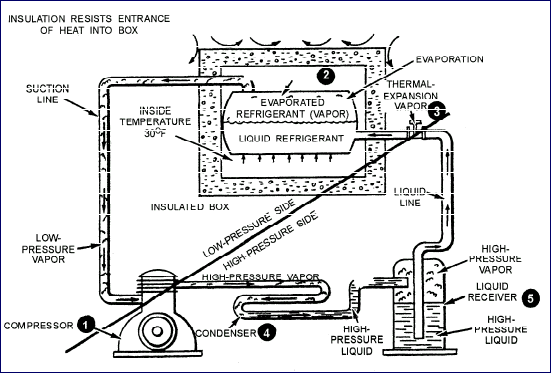| Mechanical refrigeration systems are arrangements of components in a system
that puts the theory of gases into practice to provide artificial
cooling. To do this, you must provide the following:
(1) a metered supply of relatively cool liquid under pressure
(2) a device in the space to be cooled that operates at reduced
pressure so that when the cool, pressurized liquid enters, it
will expand, evaporate, and take heat from the space to be cooled
(3) a means of repressurizing (compressing) the vapor
(4) a means of condensing it back into a liquid, removing its
superheat, latent heat of vaporization, and some of its sensible
heat
Every mechanical refrigeration system operates at two different
pressure levels. The dividing line is shown in figure below.
The line passes through the discharge valves of the compressor
on one end and through the orifice of the metering device or
expansion valve on the other.
 Refrigeration Cycle
Refrigeration CycleThe high-pressure side of the refrigeration system comprises
all the components that operate at or above condensing pressure.
These components are the discharge side of the compressor, the
condenser, the receiver, and all interconnected tubing up to
the metering device or expansion valve.
The low-pressure side of a refrigeration system consists of
all the components that operate at or below evaporating pressure.
These components comprise the low-pressure side of the expansion
valve, the evaporator, and all the interconnecting tubing up
to and including the low side of the compressor.
Refrigeration mechanics call the pressure on the The refrigerant
low-pressure vapor drawn from the high side discharge pressure,
head pressure, or evaporator by the compressor through the suction
line, high-side pressure. On the low side, the pressure is in
turn, is compressed by the compressor to a called suction pressure
or low-side pressure.
The refrigeration cycle of a mechanical refrigeration system
may be explained by using the picture above. The pumping action
of the compressor (1) draws vapor drawn from the evaporator
(2). This action reduces the pressure in the evaporator, causing
the liquid particles to evaporate. As the liquid particles evaporate,
the evaporator is cooled. Both the liquid and vapor refrigerant
tend to extract heat from the warmer objects in the insulated
refrigerator cabinet.
The ability of the liquid to absorb heat as it vaporizes is
very high in comparison to that of the vapor. As the liquid
refrigerant is vaporized, the low-pressure vapor is drawn
into the suction line by the suction action of the compressor
(1). The evaporation of the liquid refrigerant would soon
remove the entire refrigerant from the evaporator if it were
not replaced. The replacement of the liquid refrigerant is
usually controlled by a metering device or expansion valve
(3). This device acts as a restrictor to the flow of the liquid
refrigerant in the liquid line. Its function is to change
the high-pressure, sub-cooled liquid refrigerant to low-pressure,
low-temperature liquid particles, which will continue the
cycle by absorbing heat.
The refrigerant low-pressure vapor drawn from the evaporator
by the compressor through the suction line, in turn, is compressed
by the compressor to a high-pressure vapor, which is forced
into the condenser (4). In the condenser, the high-pressure
vapor condenses to a liquid under high pressure and gives up
heat to the condenser. The heat is removed from the condenser
by the cooling medium of air or water. The condensed liquid
refrigerant is then forced into the liquid receiver (5) and
through the liquid line to the expansion valve by pressure created
by the compressor, making a complete cycle.
Although the receiver is indicated as part of the refrigeration
system in the picture above, it is not a vital component. However,
the omission of the receiver requires exactly the proper amount
of refrigerant in the system. The refrigerant charge in systems
without receivers is to be considered critical, as any variations
in quantity affects the operating efficiency of the unit.
The refrigeration cycle of any refrigeration system must be
clearly understood by a mechanic before repairing the system.
Knowing how a refrigerant works makes it easier to detect faults
in a refrigeration system.
|
